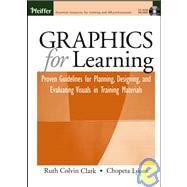
Note: Supplemental materials are not guaranteed with Rental or Used book purchases.
Purchase Benefits
What is included with this book?
Chopeta Lyons has created award-winning print and on-line learning products during her twenty years developing training solutions. Beginning in 1983 with the design of electronic educational software, she has directed teams of designers, writers, programmers, audio talent, graphic designers and artists to create custom solutions for the training needs of numerous corporations and organizations. She is the author of several articles on e-learning and the book, Discover Writing, a college textbook on writing from Prentice Hall.
| Acknowledgments | p. vii |
| Foreword | p. xiii |
| Introduction: Getting the Most from This Resource | p. xix |
| Introduction to Section 1: The Foundation | p. 3 |
| Three Views of Instructional Visuals | p. 7 |
| A Visual Design Model for Planning Graphics Systematically | p. 29 |
| Summary of Section 1 | p. 43 |
| Introduction to Section 2: How to Use Visuals to Support Psychological Learning Processes | p. 47 |
| How Graphics Influence Learning Processes | p. 51 |
| Plan Graphics That Direct Attention | p. 69 |
| Plan Graphics That Awaken Prior Knowledge | p. 89 |
| Plan Graphics That Minimize Memory Load | p. 105 |
| Plan Graphics to Help Learners Build Mental Models | p. 125 |
| Plan Graphics That Support Transfer of Learning | p. 151 |
| Plan Graphics to Motivate Learning and Manage Sizzle | p. 173 |
| Plan Graphics That Accommodate Learner Differences | p. 193 |
| Summary of Section 2 | p. 216 |
| Introduction to Section 3: How to Visualize Lesson Content | p. 221 |
| How to Visualize Procedures | p. 225 |
| How to Visualize Concepts | p. 249 |
| How to Visualize Facts | p. 265 |
| How to Visualize Processes | p. 285 |
| How to Visualize Principles | p. 305 |
| Summary of Section 3 | p. 321 |
| Introduction to Section 4: How to Plan and Communicate Your Visuals | p. 325 |
| Define the Visual Context | p. 331 |
| Design the Visual Approach | p. 353 |
| Visualize Individual Graphics | p. 373 |
| Communicate Your Graphic Plans | p. 393 |
| Apply the Principles | p. 415 |
| Summary of Section 4 | p. 438 |
| Glossary | p. 441 |
| References | p. 453 |
| About the Authors | p. 465 |
| List of Figures and Tables | p. 467 |
| Index | p. 479 |
| Pfeiffer Publications Guide | p. 505 |
| Table of Contents provided by Ingram. All Rights Reserved. |
The New copy of this book will include any supplemental materials advertised. Please check the title of the book to determine if it should include any access cards, study guides, lab manuals, CDs, etc.
The Used, Rental and eBook copies of this book are not guaranteed to include any supplemental materials. Typically, only the book itself is included. This is true even if the title states it includes any access cards, study guides, lab manuals, CDs, etc.